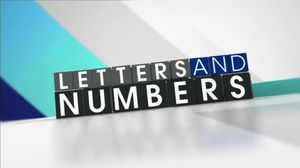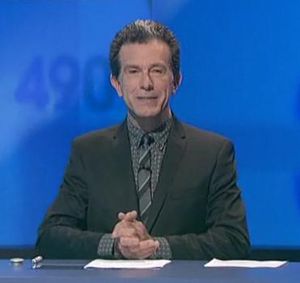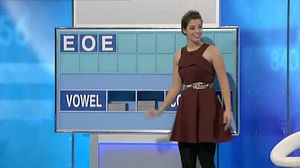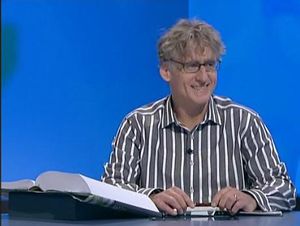Due to persistent vandalism, account creation has been suspended. If you would like an account, please contact Charlie Reams on Apterous.
Difference between revisions of "Letters and Numbers"
JohnnyCanuck (talk | contribs) (disambig) |
JohnnyCanuck (talk | contribs) |
||
| Line 12: | Line 12: | ||
The show followed a layout inspired by the British version. Shows had five [[letters game]]s, three [[numbers game]]s and a [[conundrum]], with two advertising breaks during which Word Mixes (eight-letter anagrams similar to [[Teatime Teaser]]s) are displayed for viewers. The rounds were arranged in the format LLNWLLNWLNC, with W representing a Word Mix. | The show followed a layout inspired by the British version. Shows had five [[letters game]]s, three [[numbers game]]s and a [[conundrum]], with two advertising breaks during which Word Mixes (eight-letter anagrams similar to [[Teatime Teaser]]s) are displayed for viewers. The rounds were arranged in the format LLNWLLNWLNC, with W representing a Word Mix. | ||
| − | On the Australian show, daily champions were capped at six wins instead of eight, similar to the [[viscount]]s of [[Series 46]] of ''Countdown''. | + | On the Australian show, daily champions were capped at six wins instead of eight, similar to the [[viscount]]s of [[Series 46]] of ''Countdown''. ''Letters and Numbers'' series, rather than having their start and end dates defined by calendar months, were always arranged to include exactly 100 shows, with each one consisting of 93 preliminaries (heats) followed by a 7-episode knockout finals stage similar to ''Countdown'''s, though sometimes with different seed combinations in the semi-finals. Winners of each series received a hard copy of the ''Macquarie Dictionary'', against which all words on the show were judged. |
| − | The show's original run comprised four 100-show series, each lasting roughly four months, followed by a ''Masters'' tournament (analogous to a ''Countdown'' [[Championship of Champions]]; unrelated to the morning [[Countdown Masters]] programme) comprising all four previous series champions, three runners-up and a semi-finalist. This event was won by the Series 4 champion Sam Gaffney. | + | The show's original run comprised 443 regular-play episodes (including four 100-show series, each lasting roughly four months), followed by a ''Masters'' tournament (analogous to a ''Countdown'' [[Championship of Champions]]; unrelated to the morning [[Countdown Masters]] programme) comprising all four previous series champions, three runners-up and a semi-finalist. This event was won by the Series 4 champion Sam Gaffney. |
Former ''Countdown'' contestant [[Andrew Fisher]] appeared on episode 15 of ''Letters and Numbers'' and went on to become the #1 seed and champion of the first series. | Former ''Countdown'' contestant [[Andrew Fisher]] appeared on episode 15 of ''Letters and Numbers'' and went on to become the #1 seed and champion of the first series. | ||
Revision as of 12:56, 21 August 2016
For the types of segment on Countdown, see Letters round and Numbers round.
Letters and Numbers is an Australian version of Countdown. It originally ran from 2 August 2010 to 27 June 2012 on SBS One, having been repeated in its entirety since, and is the third English-language version of the show so far. It was adapted from Des chiffres et des lettres in the same way that Countdown was in 1982. The host is Richard Morecroft.
Format
The show followed a layout inspired by the British version. Shows had five letters games, three numbers games and a conundrum, with two advertising breaks during which Word Mixes (eight-letter anagrams similar to Teatime Teasers) are displayed for viewers. The rounds were arranged in the format LLNWLLNWLNC, with W representing a Word Mix.
On the Australian show, daily champions were capped at six wins instead of eight, similar to the viscounts of Series 46 of Countdown. Letters and Numbers series, rather than having their start and end dates defined by calendar months, were always arranged to include exactly 100 shows, with each one consisting of 93 preliminaries (heats) followed by a 7-episode knockout finals stage similar to Countdown's, though sometimes with different seed combinations in the semi-finals. Winners of each series received a hard copy of the Macquarie Dictionary, against which all words on the show were judged.
The show's original run comprised 443 regular-play episodes (including four 100-show series, each lasting roughly four months), followed by a Masters tournament (analogous to a Countdown Championship of Champions; unrelated to the morning Countdown Masters programme) comprising all four previous series champions, three runners-up and a semi-finalist. This event was won by the Series 4 champion Sam Gaffney.
Former Countdown contestant Andrew Fisher appeared on episode 15 of Letters and Numbers and went on to become the #1 seed and champion of the first series.
On the Australian version's numbers games, 2 large and 4 small numbers (known as the "Family Mix", as the 2 large numbers were analogous to a pair of parents) evolved to become the most common selection, in contrast to the British show where 1 large and 5 small is most popular.



